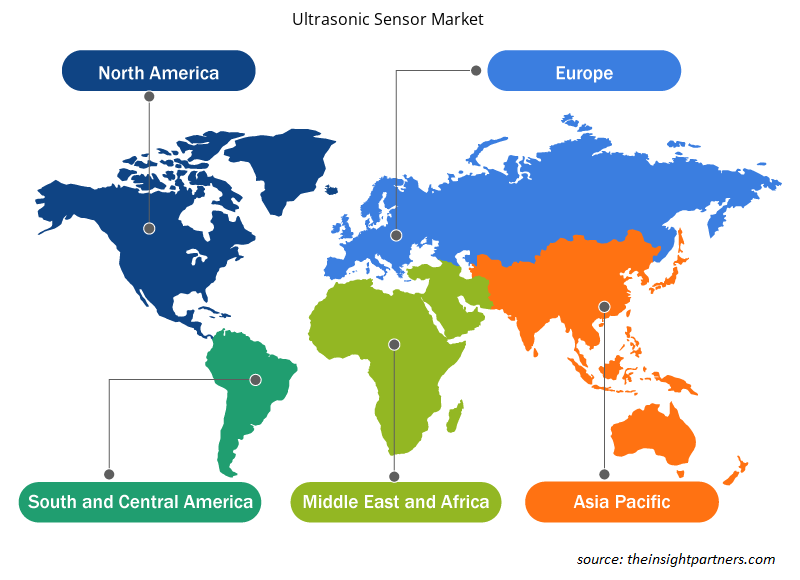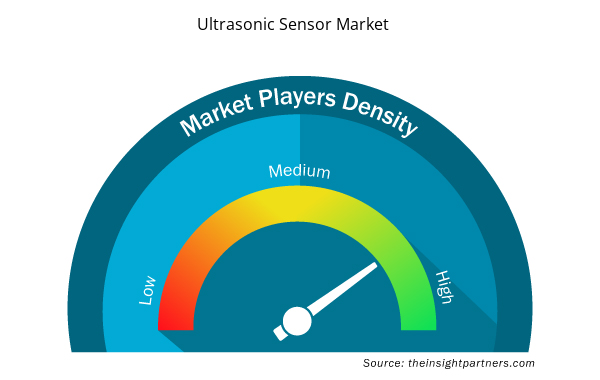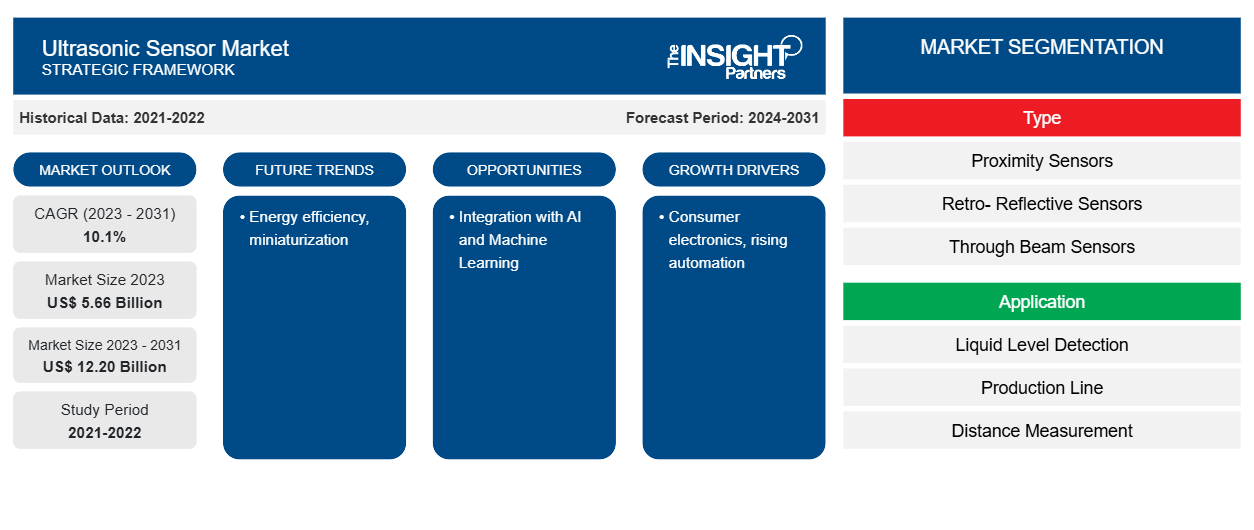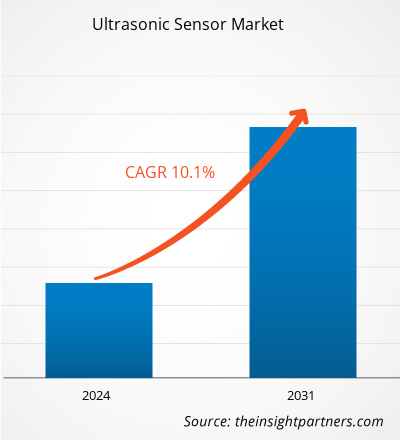Der Markt für Ultraschallsensoren soll von 5,66 Milliarden US-Dollar im Jahr 2023 auf 12,20 Milliarden US-Dollar im Jahr 2031 anwachsen. Der Markt soll zwischen 2023 und 2031 eine durchschnittliche jährliche Wachstumsrate (CAGR) von 10,1 % verzeichnen. Energieeffizienz und Miniaturisierung dürften weiterhin die wichtigsten Trends auf dem Markt für Ultraschallsensoren bleiben.
Ultraschallsensor-Marktanalyse
Ultraschallsensoren werden weltweit für eine Reihe von Anwendungen eingesetzt, sowohl im Innen- als auch im Außenbereich, unter schwierigen Bedingungen. Ultraschallsensoren können im Herstellungsprozess verwendet werden, um die Prozesssteuerung in der Fabrikhalle zu automatisieren, und sie sind auch ein wichtiges Werkzeug für Unternehmen, um die Produktivität durch präzise Messung und Steuerung zu maximieren. Ultraschallsensoren können die Entfernung zu einer Vielzahl von Objekten schätzen, unabhängig von Form, Farbe oder Oberflächenbeschaffenheit. Sie können auch ein Objekt messen, wenn es sich nähert oder entfernt. Für ähnliche Anwendungen werden Ultraschallsensoren unter anderem in wichtigen Branchen wie der Automobilindustrie, der Fertigung und dem Gesundheitswesen eingesetzt . Dies treibt das Marktwachstum voran.
Marktübersicht für Ultraschallsensoren
Die aktuelle Industrielandschaft mit massiver IoT-Integration und industrieller Automatisierung hat einen beeindruckenden Raum für die Ausweitung der Anwendungen für den Einsatz von Ultraschallsensoren geschaffen. Die steigende Automatisierungskomplexität im industriellen Umfeld führt die Nachfrage auf dem Markt an. Die Marktteilnehmer sind aktiv an der Einführung neuer und innovativer Produkte beteiligt. So stellte Toposens im August 2022 den weltweit ersten 3D-Ultraschall-Kollisionsvermeidungssensor für den Einsatz in industriellen Anwendungen vor, um die Produktivität und Sicherheit durch den Einsatz automatisierter Geräte zu verbessern.
Passen Sie diesen Bericht Ihren Anforderungen an
Sie erhalten kostenlose Anpassungen an jedem Bericht, einschließlich Teilen dieses Berichts oder einer Analyse auf Länderebene, eines Excel-Datenpakets sowie tolle Angebote und Rabatte für Start-ups und Universitäten.
- Holen Sie sich die wichtigsten Markttrends aus diesem Bericht.Dieses KOSTENLOSE Beispiel umfasst eine Datenanalyse von Markttrends bis hin zu Schätzungen und Prognosen.
Treiber und Chancen auf dem Ultraschallsensormarkt
Steigende industrielle Automatisierung begünstigt den Markt
Ultraschallsensoren sind vielseitig einsetzbare Sensoren im Bereich der industriellen Automatisierung. Es sind mehrere Varianten erhältlich, die jeweils auf eine bestimmte Anwendung zugeschnitten sind. Ultraschallsensoren in automatisierten Produktionslinien sorgen dafür, dass Roboterarme und Maschinen ordnungsgemäß funktionieren. Sie unterstützen bei Aufgaben wie der Ausrichtung von Komponenten und stellen sicher, dass Teile für die Montage oder Verarbeitung richtig positioniert sind.
Integration mit KI und maschinellem Lernen – eine Chance für Ultraschallsensoren
Ultraschallsensoren werden zunehmend mit künstlicher Intelligenz (KI) und Algorithmen für maschinelles Lernen integriert. Diese Integration ermöglicht eine intelligentere Datenverarbeitung, sodass Sensoren auf sich ändernde Bedingungen reagieren und genauere Vorhersagen treffen können. Diese Verbesserung ist vielversprechend für komplizierte Anwendungen wie vorausschauende Wartung und Qualitätskontrolle.
Ultraschallsensor-Marktbericht – Segmentierungsanalyse
Wichtige Segmente, die zur Ableitung der Marktanalyse für Ultraschallsensoren beigetragen haben, sind Typ, Anwendung und Branche.
- Basierend auf dem Typ ist der Markt für Ultraschallsensoren in Näherungssensoren, retroreflektierende Sensoren, Einweglichtschranken und andere unterteilt. Das Segment der Einweglichtschranken hatte im Jahr 2023 den größten Marktanteil.
- Basierend auf der Anwendung ist der Markt für Ultraschallsensoren in Flüssigkeitsstandserkennung, Produktionslinie, Entfernungsmessung und Andere unterteilt.
- Basierend auf der Branchenverteilung ist der Markt in die Branchen Automobil, Lebensmittel und Getränke, Medizin, Öl und Gas, Industrie und Sonstige segmentiert.
Ultraschallsensor Marktanteilsanalyse nach Geografie
Der geografische Umfang des Marktberichts für Ultraschallsensoren ist hauptsächlich in fünf Regionen unterteilt: Nordamerika, Asien-Pazifik, Europa, Naher Osten und Afrika sowie Südamerika/Süd- und Mittelamerika.
Europa dominierte dieMarkt für Ultraschallsensoren. Die zunehmende Automatisierung und Industrie 4.0 in europäischen Ländern treiben die Nachfrage nach Ultraschallsensoren in der Region an. Der Markt für Ultraschallsensoren erlebt in Nordamerika eine erhebliche Entwicklung, die auf die Entwicklung der Automobil- und Transportbranche zurückzuführen ist.
Regionale Einblicke in den Ultraschallsensormarkt
Die regionalen Trends und Faktoren, die den Ultraschallsensormarkt während des Prognosezeitraums beeinflussen, wurden von den Analysten von Insight Partners ausführlich erläutert. In diesem Abschnitt werden auch die Marktsegmente und die Geografie des Ultraschallsensormarkts in Nordamerika, Europa, im asiatisch-pazifischen Raum, im Nahen Osten und Afrika sowie in Süd- und Mittelamerika erörtert.

- Holen Sie sich die regionalspezifischen Daten für den Ultraschallsensormarkt
Umfang des Marktberichts für Ultraschallsensoren
| Berichtsattribut | Details |
|---|---|
| Marktgröße im Jahr 2023 | 5,66 Milliarden US-Dollar |
| Marktgröße bis 2031 | 12,20 Milliarden US-Dollar |
| Globale CAGR (2023 - 2031) | 10,1 % |
| Historische Daten | 2021-2022 |
| Prognosezeitraum | 2024–2031 |
| Abgedeckte Segmente | Nach Typ
|
| Abgedeckte Regionen und Länder | Nordamerika
|
| Marktführer und wichtige Unternehmensprofile |
|
Marktteilnehmerdichte für Ultraschallsensoren: Auswirkungen auf die Geschäftsdynamik verstehen
Der Markt für Ultraschallsensoren wächst rasant, angetrieben durch die steigende Nachfrage der Endnutzer aufgrund von Faktoren wie sich entwickelnden Verbraucherpräferenzen, technologischen Fortschritten und einem größeren Bewusstsein für die Vorteile des Produkts. Mit steigender Nachfrage erweitern Unternehmen ihr Angebot, entwickeln Innovationen, um die Bedürfnisse der Verbraucher zu erfüllen, und nutzen neue Trends, was das Marktwachstum weiter ankurbelt.
Die Marktteilnehmerdichte bezieht sich auf die Verteilung der Firmen oder Unternehmen, die in einem bestimmten Markt oder einer bestimmten Branche tätig sind. Sie gibt an, wie viele Wettbewerber (Marktteilnehmer) in einem bestimmten Marktraum im Verhältnis zu seiner Größe oder seinem gesamten Marktwert präsent sind.
Die wichtigsten auf dem Markt für Ultraschallsensoren tätigen Unternehmen sind:
- Toposen
- Baumer
- Rockwell Automation
- Siemens
- Honeywell International Inc
- Pepperl+Fuchs Pvt. Ltd.
Haftungsausschluss : Die oben aufgeführten Unternehmen sind nicht in einer bestimmten Reihenfolge aufgeführt.

- Überblick über die wichtigsten Akteure auf dem Ultraschallsensormarkt
Neuigkeiten und aktuelle Entwicklungen zum Ultraschallsensormarkt
Der Markt für Ultraschallsensoren wird durch die Erfassung qualitativer und quantitativer Daten aus Primär- und Sekundärforschung bewertet, die wichtige Unternehmensveröffentlichungen, Verbandsdaten und Datenbanken umfasst. Im Folgenden finden Sie eine Liste der Entwicklungen auf dem Markt für Ultraschallsensoren und Strategien:
- Der führende Elektronikhersteller Murata hat die Einführung eines neuen Ultraschallsensors angekündigt, der für den Einsatz in Automobilanwendungen vorgesehen ist. Der MA48CF15-7N zeichnet sich durch hohe Empfindlichkeit und schnelle Reaktion aus und ist in einem hermetisch versiegelten Gehäuse untergebracht, um vor dem Eindringen von Flüssigkeiten zu schützen. (Quelle: Murata Manufacturing Co., Ltd., Pressemitteilung, 2023)
Marktbericht zu Ultraschallsensoren – Abdeckung und Ergebnisse
Der Bericht „Marktgröße und Prognose für Ultraschallsensoren (2023–2031)“ bietet eine detaillierte Analyse des Marktes, die die folgenden Bereiche abdeckt:
- Marktgröße und Prognose auf globaler, regionaler und Länderebene für alle wichtigen Marktsegmente, die im Rahmen des Projekts abgedeckt sind
- Marktdynamik wie Treiber, Beschränkungen und wichtige Chancen
- Wichtige Zukunftstrends
- Detaillierte PEST/Porters Five Forces- und SWOT-Analyse
- Globale und regionale Marktanalyse mit wichtigen Markttrends, wichtigen Akteuren, Vorschriften und aktuellen Marktentwicklungen
- Branchenlandschaft und Wettbewerbsanalyse, einschließlich Marktkonzentration, Heatmap-Analyse, prominenten Akteuren und aktuellen Entwicklungen
- Detaillierte Firmenprofile
- Historische Analyse (2 Jahre), Basisjahr, Prognose (7 Jahre) mit CAGR
- PEST- und SWOT-Analyse
- Marktgröße Wert/Volumen – Global, Regional, Land
- Branche und Wettbewerbsumfeld
- Excel-Datensatz



Report Coverage
Revenue forecast, Company Analysis, Industry landscape, Growth factors, and Trends

Segment Covered
This text is related
to segments covered.

Regional Scope
North America, Europe, Asia Pacific, Middle East & Africa, South & Central America

Country Scope
This text is related
to country scope.
Häufig gestellte Fragen
In terms of revenue, the through-beam sensors segment held the major market share in 2023.
The key players holding majority shares in the global ultrasonic sensor market are Toposens, Baumer, Rockwell Automation, and Siemens
Energy efficiency and miniaturization are anticipated to bring new ultrasonic sensor market trends in the coming years.
Consumer electronics and rising automation are the major factors that propel the global Ultrasonic Sensors market growth.
The global ultrasonic sensor market was estimated to be US$ 5.66 million in 2023 and is expected to grow at a CAGR of 10.1% during the forecast period 2023 - 2031.
Trends and growth analysis reports related to Electronics and Semiconductor : READ MORE..
The Insight Partners performs research in 4 major stages: Data Collection & Secondary Research, Primary Research, Data Analysis and Data Triangulation & Final Review.
- Data Collection and Secondary Research:
As a market research and consulting firm operating from a decade, we have published and advised several client across the globe. First step for any study will start with an assessment of currently available data and insights from existing reports. Further, historical and current market information is collected from Investor Presentations, Annual Reports, SEC Filings, etc., and other information related to company’s performance and market positioning are gathered from Paid Databases (Factiva, Hoovers, and Reuters) and various other publications available in public domain.
Several associations trade associates, technical forums, institutes, societies and organization are accessed to gain technical as well as market related insights through their publications such as research papers, blogs and press releases related to the studies are referred to get cues about the market. Further, white papers, journals, magazines, and other news articles published in last 3 years are scrutinized and analyzed to understand the current market trends.
- Primary Research:
The primarily interview analysis comprise of data obtained from industry participants interview and answers to survey questions gathered by in-house primary team.
For primary research, interviews are conducted with industry experts/CEOs/Marketing Managers/VPs/Subject Matter Experts from both demand and supply side to get a 360-degree view of the market. The primary team conducts several interviews based on the complexity of the markets to understand the various market trends and dynamics which makes research more credible and precise.
A typical research interview fulfils the following functions:
- Provides first-hand information on the market size, market trends, growth trends, competitive landscape, and outlook
- Validates and strengthens in-house secondary research findings
- Develops the analysis team’s expertise and market understanding
Primary research involves email interactions and telephone interviews for each market, category, segment, and sub-segment across geographies. The participants who typically take part in such a process include, but are not limited to:
- Industry participants: VPs, business development managers, market intelligence managers and national sales managers
- Outside experts: Valuation experts, research analysts and key opinion leaders specializing in the electronics and semiconductor industry.
Below is the breakup of our primary respondents by company, designation, and region:

Once we receive the confirmation from primary research sources or primary respondents, we finalize the base year market estimation and forecast the data as per the macroeconomic and microeconomic factors assessed during data collection.
- Data Analysis:
Once data is validated through both secondary as well as primary respondents, we finalize the market estimations by hypothesis formulation and factor analysis at regional and country level.
- Macro-Economic Factor Analysis:
We analyse macroeconomic indicators such the gross domestic product (GDP), increase in the demand for goods and services across industries, technological advancement, regional economic growth, governmental policies, the influence of COVID-19, PEST analysis, and other aspects. This analysis aids in setting benchmarks for various nations/regions and approximating market splits. Additionally, the general trend of the aforementioned components aid in determining the market's development possibilities.
- Country Level Data:
Various factors that are especially aligned to the country are taken into account to determine the market size for a certain area and country, including the presence of vendors, such as headquarters and offices, the country's GDP, demand patterns, and industry growth. To comprehend the market dynamics for the nation, a number of growth variables, inhibitors, application areas, and current market trends are researched. The aforementioned elements aid in determining the country's overall market's growth potential.
- Company Profile:
The “Table of Contents” is formulated by listing and analyzing more than 25 - 30 companies operating in the market ecosystem across geographies. However, we profile only 10 companies as a standard practice in our syndicate reports. These 10 companies comprise leading, emerging, and regional players. Nonetheless, our analysis is not restricted to the 10 listed companies, we also analyze other companies present in the market to develop a holistic view and understand the prevailing trends. The “Company Profiles” section in the report covers key facts, business description, products & services, financial information, SWOT analysis, and key developments. The financial information presented is extracted from the annual reports and official documents of the publicly listed companies. Upon collecting the information for the sections of respective companies, we verify them via various primary sources and then compile the data in respective company profiles. The company level information helps us in deriving the base number as well as in forecasting the market size.
- Developing Base Number:
Aggregation of sales statistics (2020-2022) and macro-economic factor, and other secondary and primary research insights are utilized to arrive at base number and related market shares for 2022. The data gaps are identified in this step and relevant market data is analyzed, collected from paid primary interviews or databases. On finalizing the base year market size, forecasts are developed on the basis of macro-economic, industry and market growth factors and company level analysis.
- Data Triangulation and Final Review:
The market findings and base year market size calculations are validated from supply as well as demand side. Demand side validations are based on macro-economic factor analysis and benchmarks for respective regions and countries. In case of supply side validations, revenues of major companies are estimated (in case not available) based on industry benchmark, approximate number of employees, product portfolio, and primary interviews revenues are gathered. Further revenue from target product/service segment is assessed to avoid overshooting of market statistics. In case of heavy deviations between supply and demand side values, all thes steps are repeated to achieve synchronization.
We follow an iterative model, wherein we share our research findings with Subject Matter Experts (SME’s) and Key Opinion Leaders (KOLs) until consensus view of the market is not formulated – this model negates any drastic deviation in the opinions of experts. Only validated and universally acceptable research findings are quoted in our reports.
We have important check points that we use to validate our research findings – which we call – data triangulation, where we validate the information, we generate from secondary sources with primary interviews and then we re-validate with our internal data bases and Subject matter experts. This comprehensive model enables us to deliver high quality, reliable data in shortest possible time.


 Holen Sie sich ein kostenloses Muster für diesen Bericht
Holen Sie sich ein kostenloses Muster für diesen Bericht